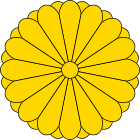- Ministry of Justice (pre-modern)
-
This article is about the Ministry of the Justice before 1871. For other uses, see Ministry of Justice (Japan).
Pre-modern Japan 
This article is part of the series:
Daijō-kan
Council of State- Chancellor or Chief Minister (Daijō-daijin)
- Minister of the Left (Sadaijin)
- Minister of the Right (Udaijin)
- Minister of the Center (Naidaijin)
- Major Counselor (Dainagon)
- Middle Counselor (Chūnagon)
- Minor Counselor (Shōnagon)
- Ministry of the Center (Nakatsukasa-shō)
- Ministry of Civil Services (Shikibu-shō)
- Ministry of Ceremonies (Jibu-shō)
- Ministry of Taxation (Minbu-shō)
- Ministry of the Military (Hyōbu-shō)
- Ministry of Justice (Gyōbu-shō)
- Ministry of the Treasury (Ōkura-shō)
- Ministry of the Imperial Household (Kunai-shō)
_____________________
Meiji government
_____________________
Postwar Shōwa period
- Imperial Household Agency (Kunaichō)
The Ministry of Justice (pre-modern) (刑部省 (前近代) Gyōbu-shō) was a division of the eighth century Japanese government of the Imperial Court in Kyoto,[1] instituted in the Asuka period and formalized during the Heian period. The Ministry was replaced in the Meiji period.
Contents
Overview
The nature of the ministry was modified in response to changing times. The ambit of the Gyōbu-shō activities encompassed, for example:
- administration and conduct of trials [2]
- oversight of the determination of the severity of punishments[2]
- regulation of the imposition of fines, imprisonments, and penal servitude[2]
History
The duties, responsibilities and focus of the ministry evolved over time. The ritsuryō system of laws were interpreted and applied by bureaucracies which distinguished punishment (gyōbushō) and censorship (danjodai). These were merged in 1871 when the Ministry of Justice (司法省 shihōshō) was established under the Constitution of the Empire of Japan.[3]
Hierarchy
The Ministry of Justice brought together a judiciary and penal system management.[4]
The top ritsuryō officials within this ministry structure were:
- chief administrator of the Ministry of Justice (刑部卿 Gyōbu-kyō)[5]
- First assistant to the chief of the Ministry of Justice (刑部大輔 Gyōbu-taifu)[5]
- Second assistant to the chief of the Ministry of Justice (刑部少輔 Gyōbu-shō)[6]
- Senior Ministry of Justice undersecretary (刑部丞 Gyōbu-no-jō)[6]
- Alternate of the Ministry of Justice undersecretary (刑部録 Gyōbu-no-sakan), two positions[6]
- Chief judge (大判事 Dai-hanji). There are three classes of officials under the control of the chief judge[6]
- First assistants to the Chief Judge (中判事 Chū-hanji)[6]
- Second assistants to the Chief Judge (少判事 Shō-hanji)[6]
- Alternate assistants to the Chief Judge (判事属 Hanji-no-sakan)[6]
- Chief prison warden (囚獄正 Shūgoku-no-kami)[6]
- First assistant prison warden (囚獄佑 Shūgoku-no-jō)[6]
- Alternate assistant prison warden (囚獄令史 Shūgoku-no-sakan)[6]
See also
Notes
- ^ Kawakami, Karl Kiyoshi. (1903). The Political Ideas of the Modern Japan, pp. 36-38. at Google Books
- ^ a b c Kawakami, p. 38 n1, at Google Books citing Ito Hirobumi, Commentaries on the Japanese Constitution, p. 87 (1889).
- ^ Nussbaum, Louis Frédéric et al. (2005). "Shihōshō" in Japan Encyclopedia, p. 855. at Google Books
- ^ Ministry of Justice, Sheffield.
- ^ a b Titsingh, Isaac. (1834). Annales des empereurs du japon, p. 431. at Google Books
- ^ a b c d e f g h i j Titsingh, p. 432. at Google Books
References
- Kawakami, Karl Kiyoshi. (1903). The Political Ideas of the Modern Japan. Iowa City, Iowa: University of Iowa Press. OCLC 466275784. Internet Archive, full text
- Nussbaum, Louis Frédéric and Käthe Roth. (2005). Japan Encyclopedia. Cambridge: Harvard University Press. 10-ISBN 0-674-01753-6; 13-ISBN 978-0-674-01753-5; OCLC 48943301
- Titsingh, Isaac. (1834). Nihon Odai Ichiran; ou, Annales des empereurs du Japon. Paris: Royal Asiatic Society, Oriental Translation Fund of Great Britain and Ireland. OCLC 5850691
Categories:- Government of feudal Japan
- Meiji Restoration
- Government ministries of Japan
- Former ministries
- Justice ministries
- Japanese history stubs
Wikimedia Foundation. 2010.
